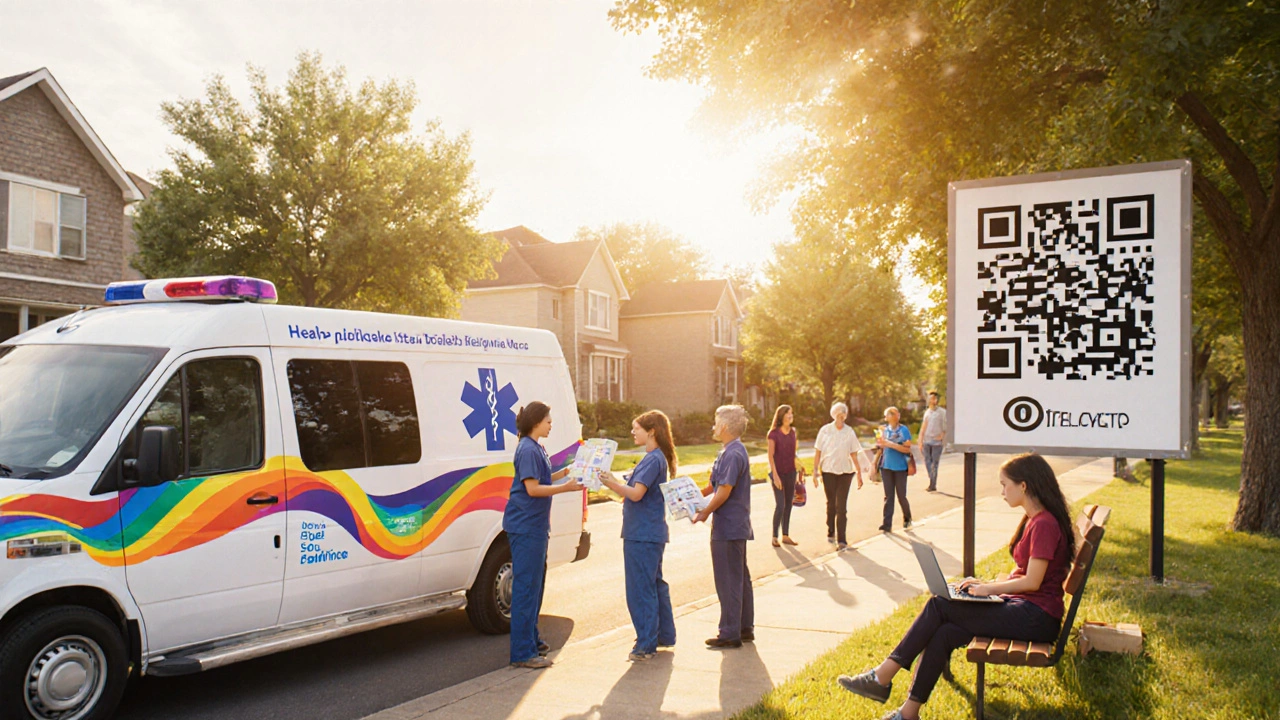Opioid Overdose Risk Calculator
Understand Your Community's Risk
Enter your community's socioeconomic data to see how these factors correlate with opioid overdose rates. Based on CDC and NIDA data, this tool shows how unemployment, income, education, and access to care impact overdose risk.
When you hear the phrase opioid addiction in the news, the first thing that comes to mind is often the grim tally of overdose deaths. But the story runs deeper-economic hardship, job loss, and community decline all weave together to fuel the crisis. This article breaks down the socioeconomic roots of the epidemic, shows how different regions are affected, and points to policies that could turn the tide.
Key Takeaways
- Opioid misuse is tightly linked to poverty, unemployment, and limited access to healthcare.
- Rural counties face higher overdose rates than many urban areas, largely because of fewer treatment resources.
- Targeted policies-like expanding Medicaid and supporting Medication‑Assisted Treatment-can cut deaths by up to 30%.
- Data from the CDC and NIDA reveal a spike in synthetic opioids, especially fentanyl, driving recent mortality spikes.
- Effective socioeconomic interventions require coordination between health, labor, and criminal‑justice systems.
What Is Opioid Addiction?
Opioid Addiction is a chronic brain disease characterized by the compulsive use of opioid substances despite harmful consequences. It encompasses prescription pain relievers (like oxycodone and hydrocodone), heroin, and synthetic opioids such as fentanyl. The condition alters neuronal pathways, making relapse more likely without proper treatment.
Why Socioeconomic Factors Matter
Economic stress is more than a backdrop-it’s a driver. Communities with high unemployment, low median income, and limited educational opportunities see higher rates of opioid misuse. The logic is simple: when people lose jobs or see dwindling prospects, some turn to opioids to cope with pain-both physical and emotional.
Research from the National Institute on Drug Abuse (NIDA) shows that counties with unemployment above 7% experience roughly 15% more opioid‑related hospital admissions than those with rates below 3%.
In addition, lack of health insurance restricts access to evidence‑based treatments. Before 2020, only 38% of people with opioid use disorder (OUD) could afford medication‑assisted treatment (MAT). Expansion of Medicaid under the Affordable Care Act lifted that figure to 62% in participating states.

Regional Disparities Across America
Geography matters. Rural Appalachia, the Rust Belt, and parts of the Southwest report overdose rates that exceed the national average by 25% to 40%.
One reason: treatment centers are sparse. In 2023, there were 1.2 opioid treatment facilities per 100,000 residents in urban counties, compared with just 0.4 in rural counties.
Meanwhile, urban centers like Philadelphia and San Francisco face a different challenge-overcrowded clinics and higher prevalence of fentanyl‑laced street drugs, which raises fatality odds.
How Synthetic Opioids Shift the Landscape
Fentanyl and its analogs have reshaped the epidemic. According to the Centers for Disease Control and Prevention (CDC), synthetic opioids accounted for 68% of all opioid‑related overdose deaths in 2022, up from 33% a decade earlier.
This surge is not just a medical issue; it’s an economic one. Illicit fentanyl is cheap to produce and profit‑driven, flooding low‑income neighborhoods with a deadly product that’s easier to obtain than prescription pills.
Policy Landscape: What’s Working?
The SUPPORT Act (Substance Use-Disorder Prevention That Promotes Opioid Recovery and Treatment) passed in 2021, allocated $4.5billion to expand treatment, improve data collection, and support law‑enforcement collaborations.
Early evaluations show a 12% reduction in overdose deaths in states that fully funded the act’s provisions.
Key policy levers include:
- Medicaid expansion: Provides coverage for MAT, counseling, and recovery services.
- Prescription‑monitoring programs (PMPs): Reduce “doctor shopping” by flagging excessive opioid prescriptions.
- Harm‑reduction sites: Offer naloxone distribution and safe‑use spaces, cutting fatal overdoses by up to 30% in pilot cities.
- Job‑training initiatives: Pairing employment programs with treatment boosts long‑term recovery rates.
Comparing Socioeconomic Indicators and Overdose Rates
| Factor | Correlation Strength | Typical Value |
|---|---|---|
| Unemployment Rate | High (r = 0.58) | 7.2% |
| Median Household Income | Medium (r = -0.45) | $48,600 |
| High School Graduation Rate | Low (r = -0.32) | 84% |
| Medicaid Coverage Rate | Medium (r = -0.41) | 59% |
| Number of Treatment Centers per 100k | High (r = -0.63) | 0.9 |
The table shows that higher unemployment and fewer treatment centers are the strongest predictors of overdose deaths. Raising median income and improving education also help, but their impact is less direct.

Real‑World Stories That Illustrate the Numbers
Take the town of Huntington, West Virginia. After the coal industry declined, unemployment rose to 9.5%. In 2022, the county recorded 102 opioid deaths-more than double the state average. A local nonprofit partnered with the state to open a mobile MAT clinic, which treated 1,200 patients in its first year and cut deaths by 18%.
Contrast that with Seattle, Washington, where unemployment sits at 4.1% and the city invested heavily in safe‑injection sites and naloxone distribution. Overdose deaths fell from 1,159 in 2020 to 842 in 2023, a 27% drop.
Practical Steps for Individuals and Communities
- Know the local resources: Search your county health department for Medicaid enrollment assistance and MAT providers.
- Support harm‑reduction efforts: Volunteer at or donate to organizations that distribute naloxone.
- Advocate for policy change: Contact state legislators to push for Medicaid expansion if it’s not already in place.
- Promote job training: Encourage local businesses to partner with workforce development programs that target people in recovery.
- Stay informed: Follow updates from the CDC and NIDA for the latest data on opioid trends.
Looking Ahead: What 2025 Might Hold
Projections from the Substance Abuse and Mental Health Services Administration (SAMHSA) suggest that, without stronger socioeconomic interventions, the U.S. could see 115,000 opioid‑related deaths by 2027. However, if Medicaid reaches 70% coverage nationwide and every county has at least one treatment center per 50,000 residents, the death toll could fall by 22%.
Technology also plays a role. Telehealth for MAT has grown 250% since 2020, making treatment more accessible to remote areas. Continued insurance reimbursement for virtual visits will be crucial.
Frequently Asked Questions
How does unemployment directly affect opioid misuse?
Job loss often leads to stress, loss of purpose, and reduced access to employer‑provided health benefits. Those pressures increase the likelihood of turning to opioids for self‑medication, and without insurance, people can’t afford evidence‑based treatments.
What is Medication‑Assisted Treatment and why is it effective?
MAT combines FDA‑approved medications-like buprenorphine, methadone, or naltrexone-with counseling. The drugs stabilize brain chemistry, reduce cravings, and lower overdose risk. Studies show MAT reduces mortality by up to 50% compared with no treatment.
Why is fentanyl such a big driver of recent deaths?
Fentanyl is 50‑100 times more potent than heroin. A tiny miscalculation can be lethal. Because it’s cheap to produce and easy to transport, dealers mix it into other street drugs, often without users knowing, leading to accidental overdoses.
How can communities without many treatment centers help?
Mobile clinics, telehealth MAT services, and community‑based naloxone programs can bridge gaps. Partnering with local pharmacies for medication distribution also expands reach.
What role does Medicaid play in reducing opioid deaths?
Medicaid covers most OUD treatments, including MAT, counseling, and inpatient rehab. States that expanded Medicaid saw a 10‑15% drop in opioid overdose mortality within three years of expansion.








Wow, this deep‑dive into the opioid crisis feels like reading a secret dossier that the powers don’t want us to see. The numbers are terrifying, especially the correlation between unemployment and overdose deaths – it's almost like a hidden agenda to keep certain communities in perpetual distress. I can’t help but wonder who's funding all these so‑called “treatment centers” and why they appear where they do. If anyone’s listening, start looking beyond the surface stats and ask who benefits from the misery.
The article presents a comprehensive overview of the socioeconomic determinants influencing opioid misuse in the United States. It systematically outlines how variables such as unemployment, median household income, and Medicaid coverage correlate with overdose mortality rates. The inclusion of empirical data from CDC and NIDA lends credibility to the assertions made. Moreover, the discussion of policy interventions, including Medicaid expansion and the SUPPORT Act, provides actionable insights for stakeholders. While the analysis is thorough, a deeper exploration of the causal mechanisms linking education level to opioid use could further enrich the discourse. Additionally, the regional disparities highlighted underscore the necessity for tailored, community‑specific strategies. Overall, the piece succeeds in bridging epidemiological evidence with policy recommendations, thereby serving as a valuable resource for public health professionals.
Holy smokes, the data on treatment center scarcity in rural areas is a gut punch. Imagine living where the nearest clinic is a two‑hour drive and still being told it’s "adequate"! This disparity fuels the drama we keep seeing on the news, and it’s high time we demand real solutions.
One could argue that the opioid epidemic is not merely a medical crisis, but a manifestation of societal neglect. When communities lose their economic backbone, the void invites substances that dull the pain of hopelessness. The philosophical implication is stark: our collective values dictate the health of the individual. If profit is placed above people, the resulting imbalance manifests as waves of addiction. Yet, hope persists in the form of grassroots initiatives that challenge the status quo. By reevaluating our priorities, perhaps we can rewrite this tragic narrative.
Seriously, all this talk about "expanding Medicaid" sounds like a band‑aid for a broken system. If they actually wanted to fix things they'd cut out the corrupt pharma cash flow.
Look, the opioid saga is a textbook case of how slick lobbying outpaces public welfare. Policy jargon gets tossed around while the streets get flooded with cheap fentanyl. The so‑called "support act" is a drop in the bucket compared to the tsunami of profit‑driven painkillers. If we keep painting the problem with half‑baked solutions, we're just feeding the beast. Let’s cut the corporate fat and fund real, community‑rooted treatment without the red tape.
Nice overview, very informative 😊
i think u guys missed the point a lil. sure, medicaid helps but it's not the whole story. y'know, many peeps still cant get the meds cuz of stigma and all. also, the fakeness of some anti‑opioid campaigns makes people skeptical. gotta look deeper than the stats.
It’s sad how many live in places where help is a mirage. The numbers speak, and they’re loud. Yet, we hear more about politics than about real people. Compassion should be the first prescription.
These stats are eye‑opening! Let's spread the word and push for more tele‑health options.
Interesting data.
While the statistics are compelling, it is equally important to consider the cultural stigmas that deter individuals from seeking treatment. In many communities, pride and fear of judgment outweigh the perceived benefits of medical assistance. This reflects a deeper societal issue that cannot be resolved solely through legislative means. Therefore, a multifaceted approach that includes community education is essential.
Alright, let’s unpack this mess with a little sarcasm, shall we? First, the article tells us that unemployment is linked to a higher risk of opioid misuse – shocking revelation, right? As if we didn’t already know that people who are out of work and broke might turn to something that gives them a fleeting sense of relief. Then we get the classic "medicaid expansion helps" line, which reads like a press release from a government agency trying to pat itself on the back. Sure, coverage is great, but why does it feel like a Band‑Aid on a bullet wound? The data also points out that rural areas have fewer treatment centers – of course they do; why would anyone want to put lifesaving services in places that are harder to reach? It’s almost as if profit motives dictate where help is allocated.
Now, let’s talk about fentanyl – the so‑called “evil twin” of opioids. The article mentions it accounts for 68% of overdose deaths. No surprise there, because cheap, potent synthetics are the favorite of drug lords and the nightmare of public health officials. But how deep does the rabbit hole go? The piece hints at job‑training programs paired with treatment, which sounds noble, yet it glosses over the fact that many of these programs are underfunded and poorly executed. It's like giving a cracked phone a piece of tape – you’re still going to lose the call.
And don’t even get me started on the SUPPORT Act. The article says it reduced deaths by 12% in some states. A nice headline, but it leaves out the massive bureaucratic red tape that has slowed down real progress. Meanwhile, policymakers keep handing out “awards” for incremental change while the crisis escalates. If you’re looking for a silver bullet, you won’t find it here; you’ll find more paperwork. So, dear readers, let’s cut the fluff, demand accountability, and push for genuine, community‑driven solutions that aren’t just another line item in a budget.
Great summary! For families looking to get help, start by checking your state’s Medicaid portal for enrollment steps. Local nonprofits often run mobile MAT clinics – they’re a lifeline in underserved areas. Don’t forget to keep naloxone kits handy; many pharmacies now provide them for free. And always stay informed through CDC and NIDA updates.